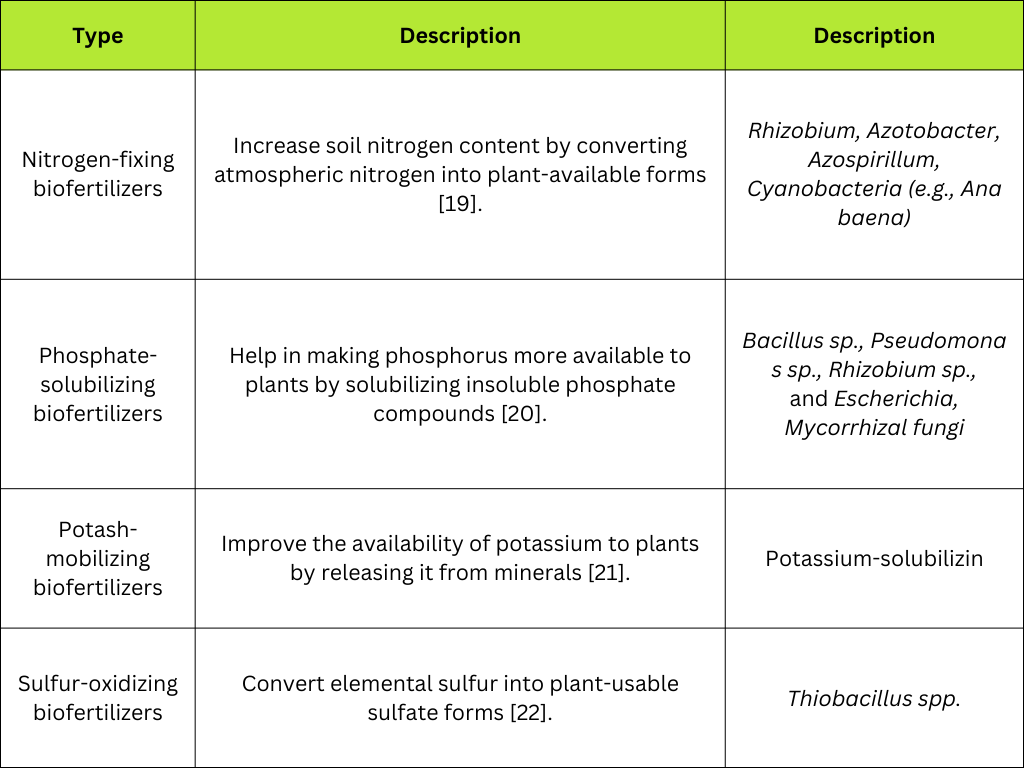Microbial Solutions for Soil Fertility and Nutrient Cycling
What are the roles of microbes in the soil?
Microorganisms, like bacteria and fungi, break down organic matter, recycle nutrients and enhance the soil structure and soil fertility. They play a crucial role in maintaining the soil’s health and fertility [1-3].
1. Nutrient Cycling
Microbes in the soil act as nature’s recyclers. They take part in every chemical reaction in soil and make nutrients available for plants uptake. They break down organic matter from dead plants and animals, transforming it into valuable nutrients such as carbon, nitrogen, phosphorous, potassium and ammonium as well as carbon dioxide that plants can absorb and are major requirements for plant growth [4-6].
2. Nitrogen Fixation
One of the important nutrients required for plant growth is nitrogen, which is often limited in supply. Some remarkable bacteria, like Rhizobium and Bradyrhizobium, can form a special relationship with leguminous plants [6]. They create nitrogen-fixing nodules on the plant’s roots, converting atmospheric nitrogen into a usable form for the plant [7]. The plant, in return, provides the microbes with nutrients [7], this reduces the need for nitrogen fertilizers and their environmental impact.
3. Mycorrhizal Fungi
Mycorrhizal fungi have a symbiotic relationship with root of plants. They form a network of thread-like structures called hyphae that expand beyond the root’s reach, enhancing the plant’s access to water and essential nutrients, particularly phosphorus and micronutrients [8]. This partnership boosts plant health and growth by improving nutrient uptake.
4. Organic Matter Decomposition
Soil microbes break down dead plant material into simpler organic compounds in a process called decomposition. This process allows plants to absorb nutrients that return to the soil, enriching them with organic matter and mineral nutrients. [9]. Studies have shown that about 90% of the nitrogen (N) and phosphorus (P) that are absorbed by plants, and 60% of other mineral elements, come from nutrients recycling during the decomposition process [10]. Nutrients like carbon, nitrogen, and phosphorus are released back into the soil through this process, this enriches its nutrient content [10]. Additionally, the humus formed during decomposition improves the soil structure and helps in retaining water in the soil, too.
5. Biological Control of Soil Pathogens
Certain soil microorganisms act as natural antagonists of harmful pathogens in the soil. Bacteria and fungi like Pseudomonas spp., Bacillus spp., Streptomyces spp., and Trichoderma are known for their ability to produce antibiotics or enzymes that help inhibit the growth of pathogens in the soil [11, 12]. Using these organisms to control the growth of pathogens is known as the biological control method, it can reduce the need for chemical pesticides, which in turn promotes an environmentally friendly pest management practice [11].
Practical Applications and Strategies
1. Organic Farming Practices
Organic farming prioritizes the preservation and enhancement of soil microbial diversity. Crop rotation, cover cropping, and reduced tillage are examples of organic farming that maintain healthy soil ecosystems [13]. Synthetic pesticides and fertilizers that can harm soil microorganisms are avoided [14].
2. Biofertilizers and Bioinoculants
Biofertilizers contain beneficial microorganisms like nitrogen-fixing bacteria and mycorrhizal fungi [15]. These fertilizers enhance nutrient availability and reduce the need for synthetic fertilizers [15]. Bioinoculants are beneficial soil amendments leveraging beneficial microbes to foster plant growth and development [16]. These formulations contain either dormant or live cells of highly efficient microorganisms, including strains proficient in nitrogen fixation, hydrogen cyanide production, and siderophore synthesis. Several plant growth-promoting microbial strains Azospirillum, Rhizobium, Bacillus, Pseudomonas, mycorrhiza, Trichoderma, and yeast, have been identified as bioinoculants [17, 18].
The tables below provide some examples of biofertilizers and bioinoculants and microorganisms involved in each.
Table 1: Some common types of biofertilizers

Table 2: Some common types of bioinoculants

3. Reduced Chemical Inputs
Minimizing the use of synthetic fertilizers and pesticides helps maintain a balanced soil microbial community. Integrated pest management (IPM) approaches prioritize biological control methods over chemical treatments, reducing harm to beneficial soil microorganisms [28].
4. Soil Restoration
Reforestation and land rehabilitation projects are efforts used to restore degraded soil. These efforts focus on rebuilding soil microbial communities that are essential for long-term soil health and ecosystem sustainability.
The richness and wellbeing of the soil are mostly dependent on soil microorganisms crucial in nutrient recycling, breaking down organic matter and inhibiting the growth of other microbes that are harmful to the soil. Utilising the potential of these soil microbes is vital for a more sustainable agriculture. Organic farming, application of biofertilizers and bioinoculants are approaches that can nurture these soil microbes, enhance soil fertility, and reduce the dependence on artificial inputs, ultimately fostering a more sustainable and robust agricultural system.
If you want to read more, please visit the section Soil and Water Conservation.
References
1. FAO (2015). Healthy soils are the basis for healthy food production. https://www.fao.org/soils-2015/news/news-detail/en/c/277682/#:
2. Gao, D., Zhao, H., Wang, L., Li, Y., Tang, T., Bai, Y., & Liang, H. (2022). Current and emerging trends in bioaugmentation of organic contaminated soils: A review. Journal of Environmental Management, 320, 115799.
3. Usman, S., Muhammad, Y., & Chiroman, A. (2016). Roles of soil biota and biodiversity in soil environment–A concise communication. Eurasian Journal of Soil Science, 5(4), 255-265.
4. Kirchman, D L. (2018). ‘Degradation of organic matter’, Processes in Microbial Ecology, 2nd edn (Oxford, 2018; online edn, Oxford Academic, 23 Aug. 2018), https://doi.org/10.1093/oso/9780198789406.003.0007, accessed 11 Sept. 2023.
5. Bhattacharyya, S. S., & Furtak, K. (2022). Soil–Plant–Microbe Interactions Determine Soil Biological Fertility by Altering Rhizospheric Nutrient Cycling and Biocrust Formation. Sustainability, 15(1), 625. https://doi.org/10.3390/su15010625
6. Basu, S., Kumar, G., Chhabra, S., & Prasad, R. (2021). Role of soil microbes in the biogeochemical cycle for enhancing soil fertility. In New and future developments in microbial biotechnology and bioengineering (pp. 149-157). Elsevier.
7. Appelbaum, E. (2018). The Rhizobium/Bradyrhizobium-legume symbiosis. In Molecular biology of symbiotic nitrogen fixation (pp. 131-158). CRC Press.
8. Liu, A., Contador, C. A., Fan, K., & Lam, H. M. (2018). Interaction and regulation of carbon, nitrogen, and phosphorus metabolisms in root nodules of legumes. Frontiers in Plant Science, 9, 1860.
9. Morgan, J. B., & Connolly, E. L. (2013). Plant-soil interactions: nutrient uptake. Nature Education Knowledge, 4(8), 2.
10. Liu, S., Yang, R., Peng, X., Hou, C., Ma, J., & Guo, J. (2022). Contributions of Plant Litter Decomposition to Soil Nutrients in Ecological Tea Gardens. Agriculture, 12(7), 957. MDPI AG. Retrieved from http://dx.doi.org/10.3390/agriculture12070957
11. Chapin, F. S., Matson, P. A., Mooney, H. A., & Vitousek, P. M. (2002). Principles of terrestrial ecosystem ecology.
12. Bonaterra, A., Badosa, E., Daranas, N., Francés, J., Roselló, G., & Montesinos, E. (2022). Bacteria as Biological Control Agents of Plant Diseases. Microorganisms, 10(9), 1759. https://doi.org/10.3390/microorganisms10091759
13. Köhl, J., Kolnaar, R., & Ravensberg, W. J. (2019). Mode of action of microbial biological control agents against plant diseases: relevance beyond efficacy. Frontiers in plant science, 845.
14. Rani, M., Kaushik, P., Bhayana, S., & Kapoor, S. (2023). Impact of organic farming on soil health and nutritional quality of crops. Journal of the Saudi Society of Agricultural Sciences.
15. Lori, M., Symnaczik, S., Mäder, P., De Deyn, G., & Gattinger, A. (2017). Organic farming enhances soil microbial abundance and activity—A meta-analysis and meta-regression. PloS one, 12(7), e0180442.
16. Bhardwaj, D., Ansari, M. W., Sahoo, R. K., & Tuteja, N. (2014). Biofertilizers function as key player in sustainable agriculture by improving soil fertility, plant tolerance and crop productivity. Microbial cell factories, 13, 1-10.
17. Chaudhary, T., Dixit, M., Gera, R., Shukla, A. K., Prakash, A., Gupta, G., & Shukla, P. (2020). Techniques for improving formulations of bioinoculants. 3 Biotech, 10(5), 199. https://doi.org/10.1007/s13205-020-02182-9
18. Aremu BR, Alori ET, Kutu RF, Babalola OO. Potentials of microbial inoculants in soil productivity: an outlook on African legumes. In: Panpatte DG, Jhala YK, Vyas RVS, editors. Microorganisms for green revolution HN. Singapore: Springer; 2017. pp. 53–75.
19. Baker, B. P., Green, T. A., & Loker, A. J. (2020). Biological control and integrated pest management in organic and conventional systems. Biological Control, 140, 104095.
20. Bhat, T. A., Ahmad, L., Ganai, M. A., & Khan, O. A. (2015). Nitrogen fixing biofertilizers; mechanism and growth promotion: a review. J Pure Appl Microbiol, 9(2), 1675-1690.
21. Tian, J., Ge, F., Zhang, D., Deng, S., & Liu, X. (2021). Roles of Phosphate Solubilizing Microorganisms from Managing Soil Phosphorus Deficiency to Mediating Biogeochemical P Cycle. Biology, 10(2), 158. https://doi.org/10.3390/biology10020158
22. Jayaswal, V. D., Pardeshi, H. D., Shirsath, L. P., & Patil, S. P. POTASH SOLUBILIZING BACTERIA: A GREEN ALTERNATIVE TO CHEMICAL FERTILIZER. Advances in Plant Science, 34.
23. Dasgupta, D., Kumar, K., Miglani, R., Mishra, R., Panda, A. K., & Bisht, S. S. (2021). Chapter 1 – Microbial biofertilizers: Recent trends and future outlook. In S. De Mandal & A. K. Passari (Eds.), Recent Advancement in Microbial Biotechnology (pp. 1-26). Academic Press. ISBN 9780128220986. doi: 10.1016/B978-0-12-822098-6.00001-X
24. Naseer, I., Ahmad, M., Nadeem, S.M., Ahmad, I., Najm-ul-Seher, Zahir, Z.A. (2019). Rhizobial Inoculants for Sustainable Agriculture: Prospects and Applications. In: Giri, B., Prasad, R., Wu, QS., Varma, A. (eds) Biofertilizers for Sustainable Agriculture and Environment . Soil Biology, vol 55. Springer, Cham. https://doi.org/10.1007/978-3-030-18933-4_11
25. Díaz-Urbano, M., Goicoechea, N., Velasco, P., & Poveda, J. (2023). Development of agricultural bio-inoculants based on mycorrhizal fungi and endophytic filamentous fungi: co-inoculants for improve plant-physiological responses in sustainable agriculture. Biological Control, 105223.
26. Okon, Y., & Itzigsohn, R. (1995). The development of Azospirillum as a commercial inoculant for improving crop yields. Biotechnology advances, 13(3), 415–424. https://doi.org/10.1016/0734-9750(95)02004-m
27. Doni, F., Isahak, A., Che Mohd Zain, C. R., Mohd Ariffin, S., Wan Mohamad, W. N., & Wan Yusoff, W. M. (2014). Formulation of Trichoderma sp. SL2 inoculants using different carriers for soil treatment in rice seedling growth. SpringerPlus, 3, 532. https://doi.org/10.1186/2193-1801-3-532
28. Tahir, H. A. S., Gu, Q., Wu, H., Niu, Y., Huo, R., & Gao, X. (2017). Bacillus volatiles adversely affect the physiology and ultra-structure of Ralstonia solanacearum and induce systemic resistance in tobacco against bacterial wilt. Scientific reports, 7(1), 40481.










































































